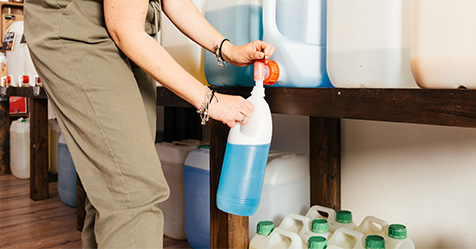San Francisco Public Transit Cleaners Face Rough Ride
Syringes, graffiti, and even chickens are some of the things crews tackle.
A recent video by KPIX-TV highlights the challenging situations that professional cleaning crews aboard the Bay Area Rapid Transit (BART) system in San Francisco deal with daily.
According to its website, BART, a heavy-rail public transit system, connects the San Francisco Peninsula with communities in the East Bay and South Bay and serves 50 stations within five counties along 131 miles of track. In 2022, it served 227,937 riders a week—a number that represented just 29% of its ridership in 2019.
Reasons for that decline—and the challenges that cleaning crews must face—include crime, drug use, and San Francisco’s homeless problem, KPIX reports.
In a “ride-along” in August, BART’s General Manager, Bob Powers; BART police officers; and local politicians got together to discuss ways to improve the experience for riders. One of those ways included increased cleaning of the trains.
“BART 2023 is focusing on the customer experience. We have double the officers walking trains and platforms. We’ve doubled vehicle cleaning,” Powers told KPIX.
Cleaning transit trains and stations in a city that in 2022, according to its own statistics, had 7,754 unhoused individuals—4,397 without shelter access—is no small feat. An article in February by The San Francisco Standard confirmed that BART is struggling with the city’s homeless crisis, with federal spending on social service interventions for the system predicted to run out in two more years.
Larose Sledge, an unhoused mother of four who is also struggling with mental illness and drug addiction, told the Standard that she rides BART trains as often as three times a week, as she prefers them to homeless shelters—one of many who see BART as a safe shelter alternative.
In the video report, a syringe is shown stuck into the back of a passenger seat, and coffee is spewed all over a train’s floor while a passenger is shown openly engaging in drug use, revealing the unusual conditions BART’s cleaning crews are up against.
“I’ve seen a lot of things on these trains,” Demariante Clark, a BART cleaner, told KPIX. “I’ve seen animals. I’ve seen chickens.”
“We usually see gum, graffiti,” said Rose Burditt, a BART foreworker who was overseeing the crew on the report and pointing out grime during her team’s deep cleaning.
These deep cleans, where everything is being cleaned “from top to bottom,” were originally being performed every 900 hours but are now being done every 400 hours, Burditt said. A deep cleaning of one train car requires two to three employees, working two to three hours to get the job done. The train car is first completely scrubbed with large brushes, and then all surfaces are sprayed with disinfectant.
The BART fleet has newer trains that are supposed to be easier to clean, but removing graffiti is still difficult and not always successful.
Beyond the deep cleaning, the trains are swept twice a day and are cleaned out at the end of the day.
“You never know what you’re getting with a train,” Clark said of the cleaning tasks that await him. “The only thing you know is the ending result—you’re going to get a clean train.”


